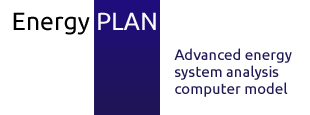Here you will find some step-by-step training for EnergyPLAN. Please note that the exercises currently work in versions EnergyPLAN 11.4 to 13.2 if you want to get the same results as those reported here. By following the guidelines and doing the exercises below, you will become acquainted with EnergyPLAN. First, download and install the EnergyPLAN model on your computer. Then, print the exercises and guidelines below and learn how to use the model step by step. In total, there are 6 exercises:
- Define and calculate a simple national energy system
- Make Simple Energy System Analyses
- More Simple Energy System Analyses
- Advanced Energy System Analysis: Excess Electricity diagrams
- Feasibility Studies and Market Exchange Studies
- Local Energy system analysis: Simple calculations of small energy system
Exercise 1: Define and calculate a simple national energy system
Exercise 1 introduces you to the EnergyPLAN model. Together with “How to do Exercise one”, the exercise shows you how to define a simple energy system and make a few calculations:
- Define an electricity demand.
- Define wind power and a power plant.
- Define district heating and individual house heating.
- Define industrial fuel demand and heat and electricity productions.
- Define fuel demand for transportation.
Exercise 2: Make Simple Energy System Analyses
In exercise 2, you are asked to do a couple of energy system improvements of the energy system of exercise 1. Through the exercise and the guideline, you learn step by step how to analyse changes to the energy system.
- Energy conservation in house heating
- Replace district heating boilers with CHP
- Add 3000 MW off-shore wind power
- Implement electricity-saving measures
- Add heat pump and heat storage capacity to CHP plants
Exercise 3: More Simple Energy System Analyses
Exercise 3 continues from exercise 2 and here, you are asked to implement more energy system improvements in the energy system. Through the exercise and the guideline, you learn step by step how to analyse more changes to the energy system:
- Add Waste Resources
- Waste Resources used for producing biogas for transportation
- Wind and hydrogen for transportation
- Add Solar Thermal in Individual houses
- Add Solar Thermal to the district heating system
Exercise 4: Advanced Energy System Analysis: Excess Electricity diagrams
In Exercise 4, you are asked to make Excess Electricity, CO2 and Primary Energy Supply Diagrams of a predefined reference system and two alternatives. Such diagrams are able to show the ability of a given energy system to integrate fluctuating renewable energy sources such as wind power:
- Make an Excess Electricity Diagram of the reference system
- Use the model “Run serial calculation” function
- Compare three different energy systems (open system)
- Compare three different energy systems (closed system)
- Compare the three energy systems of the IDA Energy Year 2006
Exercise 5: Feasibility Studies and Market Exchange Studies
In Exercise 5, you are asked to conduct Feasibility Studies and Market Exchange Studies of pre-defined energy systems:
- Make a Feasibility Study of the IDA 2030 Energy Plan
- Make a simple Market Exchange Study
- Make an advanced Market Exchange Study
- Optimise the wind power capacity in the system
Exercise 6: Local Energy system analysis: Simple calculations of small energy system
In this exercise, you can model a number of different options for heating a local community. It includes informative calculations of typical small local energy systems comparing different heating options and the impact on required power production capacitities, fuel demands and CO2-emissions
- Description
- A guideline for the solution is not available yet.



